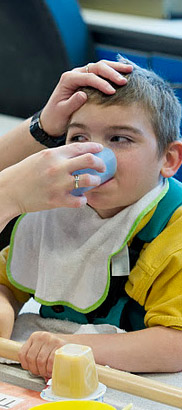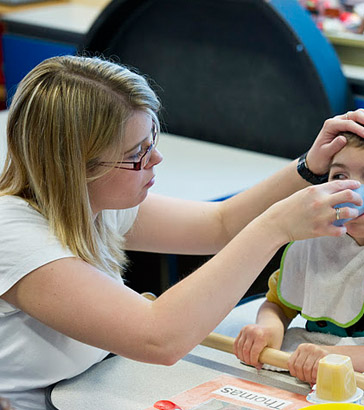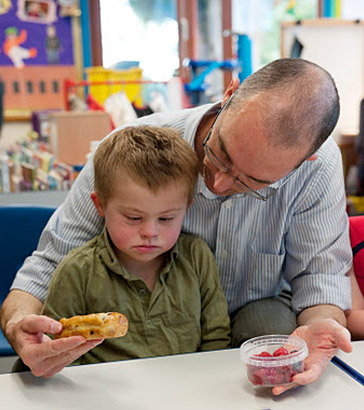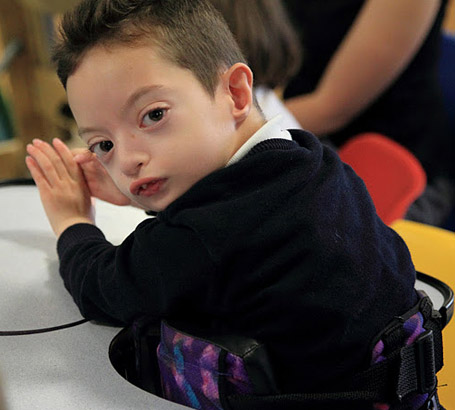
In order to achieve a positive experience for each person,
attention must be paid to the promotion of dignity and privacy and to the recognition of the uniqueness of each person.
Smith and Field, 2010

...as well as ensuring that each individual has access
to high quality and meaningful activity throughout their lives.
Mencap, 2010
Children with severe, profound or complex learning difficulties (SLD/PMLD/CLDD) often have difficulties in carrying out personal care without support. Many will need personal care support in one or more areas from families and practitioners throughout their lives.

Areas of personal care include:
- Eating and drinking (including oral health).
- Dressing/undressing (including choosing clothes).
- Toileting and toilet training, and menstruation (including continence and sanitary pads).
- Personal hygiene (including washing, shaving, brushing hair, make-up, etc.)
- Dealing with bodily fluids.
- Medication, medical procedures and physical health tasks.
- Maintaining mental health.
(Lenehan et al, 2004)
There is a difference in what people think of as personal and intimate care. At this Level B, 'personal care' includes 'intimate care'.
For information on emotional well-being and mental health, see the module Emotional Well-being and Mental Health.
from abuse

Children with SLD/PMLD/CLDD are vulnerable. In situations of personal care there is greater potential for actual abuse and accusation of abuse than in less intimate situations.
Safeguarding is important and complex. All people working with children must have a current Criminal Records Bureau (CRB) disclosure - standard or enhanced - and undergo recognised training in safeguarding children including child protection.
Within this module the emphasis is placed on safeguarding related to the provision of personal care. Materials do not cover wider safeguarding issues independently.

Safeguarding and promoting the welfare of children is defined by HM Government (2010; bullets added) as:
- The process of protecting children from abuse or neglect.
- Preventing impairment of their health and development.
- Ensuring they are growing up in circumstances consistent with the provision of safe and effective care.
- Enabling children to have optimum life chances and enter adulthood successfully.

Vulnerability increases when a person enters unfamiliar
surroundings, relationships or situations.
Smith and Field, 2010
An American study found that 'children with disabilities were 3.4 times more likely to be maltreated than non-disabled peers':
- 3.8 times more likely to be neglected.
- 3.8 times more likely to be physically abused.
- 3.1 times more likely to be sexually abused.
- 3.9 times more likely to be emotionally abused.
(Sullivan and Knutson, 2000, in PW Threlfall Training and Consultancy, 2010)

...people with learning disabilities, especially those
with profound and complex disabilities, may be unable to communicate feeling unsafe or things that may have happened to them.
Staff should be alert for signs of emotional or physical changes and changes in behaviour that might indicate abuse.
Highland Learning Difficulties and Relationships Group, 2007
Abuse may be accidental or intentional, and include:
- Neglect
- Physical abuse
- Emotional or psychological abuse
- Sexual abuse
- Discriminatory abuse
- Financial abuse
- Institutional abuse

The principles from human rights legislation, and the factors identified as important for all children in keeping themselves safe from harm, apply equally to those with SLD /PMLD /CLDD.
Children with SLD /PMLD /CLDD need support, encouragement and teaching of specific skills so they can exercise their rights. As far as possible, it is important that people working with them promote their ability to exercise choice, control and independence in self-care, and to avoid, identify and communicate abuse.

Principles and values which promote the safety of children with disabilities include:
- Empowerment of individuals (e.g. independence, realisation of potential, ability to say 'no').
- Promotion of choice.
- Promotion of rights (to dignity and privacy, safety and security).
- Recognition of preferences.
- Involvement of individuals in planning their support.
- Respect for diversity, including individual identity, cultural beliefs, moral beliefs and values.
- Anti-discriminatory practice.
- Maintaining confidentiality.
(Billingham et al, 2010)

Billingham, M., Davenport, P., Herne, D., McKie, S., Snaith, M., Stretch, B., Talman, H. and Whitehouse, M. (2010) BTEC Level 3 National Health and Social Care: Student Book 2. Harlow: Pearson/Edexcel.

Lenehan, C., Morrison, J. and Stanley, J. (2004) The Dignity of Risk: A practical handbook for professionals working with disabled children and their families. London: Council for Disabled Children/Shared Care.

Smith, B. and Field, L. (2010) Privacy and dignity. In: B. Smith and L. Field (2010) Nursing Care: An essential guide for nurses and healthcare workers in primary and secondary care. Harlow: Pearson Higher Education.
Sullivan, P.M. and Knutson, J.F. (2000) Maltreatment and disabilities: a population based epidemiological study, Child Abuse and Neglect, 24 (10), 1257-1273.